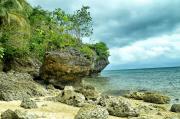The Shoe Museum was conceived in 1998 under then Mayor Bayani F. Fernando on the assumption that the city, being the Shoe Capital of the Philippines, can be a significant venue for nurturing the historical and cultural values of its shoe industry. It was opened in February 16, 2001 and was initially called the Footwear Museum of Marikina.
The building which houses the museum was used as an arsenal during the Spanish period. It was also a detention cell during the Filipino-American war where General Macario Sakay, one of the leaders of the Katipunan, was held. At the latter part of the American regime, it was converted into a motor pool for American soldiers. After the Second World War, the Tuason family used the building as a rice mill for the entire hacienda.
Shoe making is a striking manifestation of Marikenos industry, creativity, passion, and the entrepreneurial spirit. The Shoe Museum captures these traits and, in the process, firmly establishes Marikina’s pre-eminent place in the country’s shoemaking industry
History of the Museum
The Shoe Museum was conceived in 1998 under then Mayor Bayani F. Fernando on the assumption that the City, being the Shoe Capital of the Philippines, can be a significant venue for nurturing the historical and cultural values of its shoe industry. It was opened in February 16, 2001 and was initially called the Footwear Museum of Marikina.
The building which houses the museum was used as an arsenal during the Spanish period. It was also a detention cell during the Filipino-American war where General Macario Sakay, one of the leaders of the Katipunan, was held. At the latter part of the American regime, it was converted into a motor pool for the American soldiers. After the 2nd World War, the Tuason family used the building as a rice mill for the entire hacienda.
Shoemaking is a striking manifestation of Marikenos industry, creativity, passion, and the entrepreneurial spirit. The Shoe Museum captures these traits and, in the process, firmly establishes Marikina’s pre-eminent place in the country’s shoemaking industry.
The Collection
The Shoe Museum is deftly organized into the following collections: that of the world reknowned shoes of former Philippine First Lady, Imelda Marcos; assortment of shoes worn by personages.
such as former Philippine presidents, vice presidents, senators, ambassadors, and Marikina mayors; traditional footwear from various countries; and a collection of entries to city-sponsored shoe design competitions.
The museum acquaints us with the know how of making shoes with the shoe lasts used as master mold of a shoe and the different animal skins used like alligator skin, snake skin, pigskin, calfskin and sheepskin. It also exhibits a life-size diorama that shows shoemaking in Marikina as was done during the early stages of its shoe industry. The 800 pairs of shoes of Mrs. Marcos, are part of the 3,000 pairs collection which she accumulated performing her duties as first lady during her husband’s 20-year incumbency. She wore those shoes at meetings with dignitaries both here and abroad. Photos showing Mrs. Marcos during key state occasions accompany some of the shoes on display. These shoes now benefit the local shoe and fashion designers and manufacturers as they carry the exquisite designs and fine craftsmanship of the foreign shoe artisans.
Accommodations
- Marikina Hotel - Pio Del Pilar St. cor. Tangerine St., Brgy. Concepcion II, Marikina City Philippines
- La Trinidad Pension House
- Family Lodging House - 31 Liamzon St., Brgy. San Roque
- Family Lodging House - 31 Liamzon St., Brgy. San Roque
- Villa Ronar Garden Resort & Hotel - 112 Dao corner Champaca St., Marikina Heights, Marikina City
- RELC - Dormitory
- MIST-TESDA
Restaurants
- Pan De Amerikana
- Cafe Qizia - Italian Cuisine
- Tapsi ni Vivian
- Macky's Eatery
- Dalay's - Filipino Cuisine
- Cafe Kapitan
- Kusina ni Kambal
- Panciteria ni Edong's
- Kubo sa Tuazon
- Cafe Lidia
- Casa Feliz Cakes & Pastries
- Pap's Dinner
- Eriz’s Driveway bar and resto Café
- NOHMU (Resto Bar)
Transportation
Currently, elevated light rail systems run through Marikina City. The first or last station of LRT 2 is Santolan located along Marcos Highway. The station connects to Claro M. Recto Avenue in Manila.
Public transportation within the city, like in most of the urban areas in the Philippines, is facilitated mostly using inexpensive jeepneys and buses. Tricycles (motorbikes with an attached two-seater carriage) are the usual transportation used for short distances, while Taxi cabs are used by the upper middle class. The roads are organized around a set of long narrow and circumferential roads that radiate and circle in and around the city.
One of the most notable attractions in Marikina is the bikeways and bike lanes along major roads and streets. This is the only city in the Philippines which has an effective bikeway.
Going to Marikina
Various land transportation ply the route going to Marikina City via bus in major roads or public jeepneys in minor roads in Metro Manila. From Cainta and Antipolo via Marikina City (bayan): Take a jeepney with the sign board (Cubao), ask the driver to drop you at Mcdo Marcos highway and ride a tricycle going straight to Marikina Sports Center.
Or drop by at Fiesta Villa in A. Tuazon Marikina and ride a jeep with the sign board (going to Marikina).
From Quezon City via Marikina City( BAYAN):
Take a ride either Fx or jeep at Gateway Cubao, ride with the signboard going to Parang, SSS, Kalumpang, and they’ll drop you off to Marikina Bayan.
From Pasig City via Marikina City (BAYAN):
Take a jeepney in Pasig Palengke and ride with the signboard going to Marikina(bayan).
From San Mateo via Marikina (BAYAN):
Take a jeepney with the signboard Marikina (bayan)










